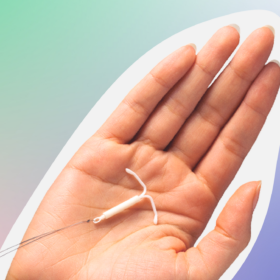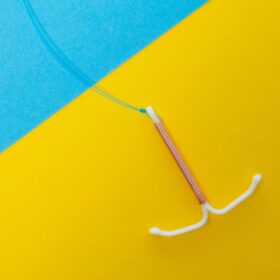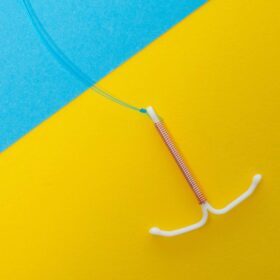
Mirena coil removal – how long does it last and what happens next?
In this article
What's the lowdown?
The Mirena coil can be used for 8 years
If you have it inserted at the age of 45 or over, it can be used for contraception until you are 55
Removal is easier than having the Mirena inserted *phew*
After a vaginal examination, a clinician will gently pull the threads, removing the coil from your womb
You may experience some cramping or bleeding for a few days after the coil removal, but talk to a healthcare professional if the pain persists
From a contraceptive point of view, the coil won’t run out until after the expiry date but some people do notice a return of bleeding or ovulation / cyclical PMS symptoms towards the end of the 8 years
The Mirena coil is a common method of contraception and is most loved for its effectiveness, convenience, longevity and role in treating heavy periods and other medical conditions. It appears that there’s always a lot of talk about how it goes in, but do we know how it comes out?
This post covers everything you need to know about coil removal, from what to expect, to possible side effects and even the ‘Mirena crash’.
When to remove or replace the Mirena or hormonal coil
The most common reasons for having your hormonal coil removed or replaced include:
- if your coil is due to be replaced
- you wish to switch to another method of contraception
- you’re not tolerating the side effects of the coil
- you’re experiencing pain
- or you wish to become pregnant
For some women, having the coil removed may be recommended by their doctor.
What to expect when having your coil removed
Coil removal is a quick procedure that can happen at any time by a trained doctor or nurse, most commonly in a GP practice or sexual health clinic.
You will need to get undressed from the waist down and have a vaginal examination using a speculum, the same examination as when the coil is inserted. (Don’t worry, it’s simpler then having it fitted – read more on coil fittings).
The doctor will gently pull on the coil threads that should be easily visible in the vagina at the neck of the womb. The T-shaped coil then folds up and it can be pulled out of the womb. Often, the clinician may ask you to cough as this can help ease the coil out without much of a pull at all.
Some coil removals can be more difficult, for example, if the threads are not easily visible. In these cases, clinicians have a very handy tool that can retrieve coil threads that have moved up into the cervix, but if this doesn’t work, you may need to be referred for an ultrasound scan or to a gynaecologist or contraception clinic. When the coil is out, it should be checked that it is all in tact, as very rarely a part of the coil may break off during removal, possibly when the cervical opening is very tight. If this happens, clinicians will arrange a scan and further removal.
If you don’t want to get pregnant, you’ll need to make sure you don’t have sex or will need to use condoms for seven days before you have the Mirena coil removed. This is advised even if you are having the coil replaced in case there is a problem with fitting a new coil. If you wish to switch to another method your healthcare professional may advise you to start this before you have your coil removed.
Mirena coil removal side effects
After your Mirena coil removal, you may expect to experience mild pain, cramps or bleeding which should resolve within a few days. Some women also report feeling tired or having headaches although it’s uncertain whether these side effects are due to Mirena removal.
If any symptoms persist or you feel unwell please consult your GP or sexual health clinic.
Depending on your reason for having the Mirena coil removed – and whether you switch to another contraceptive method – you may experience symptoms associated with a return of your normal menstrual cycle. This could include symptoms of premenstrual syndrome (PMS), or other underlying conditions previously treated by the action of the Mirena coil.
It is possible this may explain many of the varied symptoms some women report after Mirena coil removal. If you are concerned about the symptoms you are experiencing, or are worried about your health, please speak to your GP.
Check out our Mirena coil reviews to read about women’s experiences of having the Mirena coil removed.
Is your Mirena coil running out?
To understand this commonly asked question, first we need to understand how the Mirena coil works…
After it is inserted, the Mirena coil releases a hormone called levonorgestrel, much like progesterone which is normally produced by the female body. This works to prevent pregnancy by thinning the lining of your womb so it’s less likely to accept a fertilised egg (which often makes your periods lighter and sometimes disappear!).
It also thickens the mucus in your cervix. This makes it difficult for sperm to move through it and reach an egg. In some people, it stops the ovaries from releasing an egg (ovulation), but most women continue to ovulate.
So how long does the Mirena coil last?
The Mirena coil is able to be used for contraception for 8 years if you are under the age of 45. However we know women often worry their Mirena coil may stop working before then or that its effects may be wearing off. According to the Faculty of Sexual and Reproductive Health (FSRH) in the UK, the Mirena coil releases approximately 20μg of levonorgestrel a day, reducing to below 9μg per day after 6-8 years. This is still an effective amount of progestogen for contraception, but may also explain why some users start to develop different side effects throughout their time using the coil. If your coil removal is overdue, you should consider additional contraceptive precautions (e.g. condoms or the progestogen-only pill which can be bought online) until the coil can be replaced.
If you use the Mirena to control heavy periods, this should be changed after 5 years if the symptoms return. However, it can be left in for up to 8 years if it is still controlling your heavy bleeding.
If you are over 45 years old at the time you have your Mirena coil fitted then you can rely on it for contraception, without getting it replaced, until you are 55 years old. However, if you are using your Mirena coil as part of hormone replacement therapy (HRT) to manage menopausal symptoms, then this must be changed after 5 years (read more in our guide to Mirena and the menopause). If you’re not sure when to get your Mirena replaced or would like to find out more about getting it removed, speak to one of our friendly female doctors for expert advice on all things contraception.
What about if my Mirena coil has moved out of place?
Some studies have shown that the coil may not be not as effective if it has moved 2cm or more away from the top of the uterus. You can check its position by following our how-to guide to checking coil threads.Signs that your Mirena coil may have moved or come out include:
- You can’t feel your coil strings
- The strings feel much longer or shorter than usual
- You can feel the plastic part of the coil
- Your partner can feel your coil during sex
- You have pain in your pelvic area or lower tummy
- Your bleeding pattern has suddenly changed e.g. you previously had no periods now you are bleeding
- Your vaginal discharge has changed in smell or colour – this could be a sign of infection so visit your GP quickly
If you can’t feel your coil strings, or have any of the above symptoms, speak to your GP or go to your local sexual health clinic for an examination.
‘Mirena crash’
What is the ‘Mirena crash’? The ‘Mirena crash’ refers to how some women feel after their Mirena coil is removed. You may experience varied symptoms including:
- mood changes
- fatigue
- reduced libido
- headaches
- tender breasts
There is no definition of the ‘Mirena crash’ in medical literature and there is no scientific evidence for or research into this. For some women, Mirena crash symptoms appear recurrently before each period, lasting for months. We think that the ‘Mirena crash’ is actually PMS or symptoms a woman would have had due to normal hormonal fluctuations if they hadn’t used a Mirena coil. If you are experiencing sore boobs, starflower oil is a little-known life saver when it comes to easing inflammation. Purchase from Amazon here (affiliate link!)
When will your periods and fertility return after the Mirena?
One of the great benefits of the Mirena coil/IUS is that it thins the lining of your womb which makes periods lighter or disappear completely (good times for those with heavy periods). After removal, it can take time for this lining to build back up again.Our reviews show that after Mirena coil removal, the majority of women find their usual menstrual cycle returns within a few months (around 1 in 3 of our reviewers have their first period within a month!) If your periods do not return after 6 months of removal then we recommend seeking medical advice to investigate for an underlying cause, NOT due to having had the Mirena.
Had your Mirena removed and still no period?
An important thing to remember is that you can get pregnant without having a period as the ovaries can still release an egg. A review of return to fertility after different contraception showed that the 1-year pregnancy rates for women were the same whether they had stopped using coils, implants and pills as well as barrier methods like condoms.The review also found that the pregnancy rates 1 year after IUS removal (including the Mirena) were between 79-96%, which is similar to that of stopping using condoms. Find out more in our guide to contraception and the return to fertility. If you’re looking to try a new contraception method after the Mirena, take our contraception recommender quiz to find your match.
Our medical review process
This article has been medically reviewed for factual and up to date information by a Lowdown doctor.






